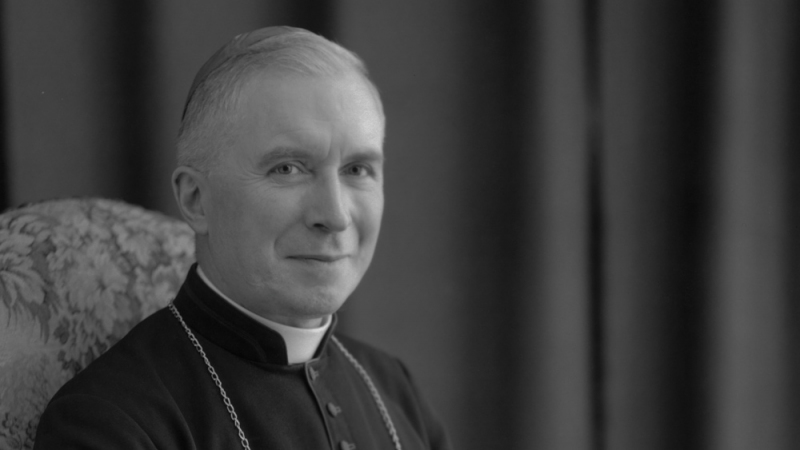Although canonically-irregular, the SSPX (Society of Pope St. Pius X) founded by Archbishop Lefebvre (above picture) in the 1970s, is not schismatic. In traditional papal encyclicals, a “schismatic community” is a Christian community adhering to valid sacraments but without recognizing the primacy of place of Rome or the importance of the papacy. An example of this would be the Eastern Orthodox: The Eastern Orthodox have valid sacraments, but many do not realize the primacy of place of Rome (or believe it was transferred due to error a thousand years ago.) In any case, the SSPX has always recognized the papacy and the primacy of Rome. The reciprocal is also true, namely, that every Pope since foundation of the SSPX in the 1970s has recognized the validity of their sacraments. Thus, they do not fit the classic definition of “schism.” Not even by a long shot.
Then why is there so much confusion?
Although Pope John Paul II putatively excommunicated Archbishop Lefebvre and the bishops he consecrated in 1988, this ex-communication of SSPX bishops was lifted by Pope Benedict XVI in 2009. (I write putatively excommunicated because I think it can be seen from the 1983 Code of Canon Law that consecration of bishops without papal approval must be proved to be ex-dolo—that is, out of malice. Malice is something the missionary to Africa, Archbishop Lefebvre, clearly did not have for the Church. In fact, the new code of canon law heavily puts the emphasis on conscience. Lefebvre was clearly following his conscience in consecrating bishops without the approval of Rome.)
But even if the excommunications in 1988 by Pope John Paul II were valid, the Vatican website now shows the lifting of the excommunications of the SSPX bishops in 2009. Approved by Pope Benedict XVI and written by Cardinal Giovanni Battista Re, the Vatican website still has the following from 2009:
DECREE REMITTING THE EXCOMMUNICATION “LATAE SENTENTIAE” OF THE BISHOPS OF THE SOCIETY OF ST PIUS X
In a letter of 15 December 2008 addressed to Cardinal Dario Castrillon Hoyos, President of the Pontifical Commission “Ecclesia Dei”, Mons. Bernard Fellay writing also in the name of the other three Bishops consecrated on 30 June 1988 requested once again the removal of the excommunication latae sententiae formally declared by a Decree of the Prefect of this Congregation for Bishops on 1 July 1988. In his letter, Mons. Fellay stated, among other things, that “we continue firmly resolute in our desire to remain Catholics and to put all our strength at the service of the Church of our Lord Jesus Christ, which is the Roman Catholic Church. We accept her teachings in a filial spirit. We firmly believe in the primacy of Peter and in his prerogatives, and for this reason the current situation causes us much suffering”.
His Holiness Benedict XVI in his paternal concern for the spiritual distress which the parties concerned have voiced as a result of the excommunication, and trusting in their commitment, expressed in the aforementioned letter, to spare no effort in exploring as yet unresolved questions through requisite discussions with the authorities of the Holy See in order to reach a prompt, full and satisfactory solution to the original problem has decided to reconsider the canonical situation of Bishops Bernard Fellay, Bernard Tissier de Mallerais, Richard Williamson and Alfonso de Galarreta, resulting from their episcopal consecration.
This act signifies a desire to strengthen reciprocal relations of trust, and to deepen and stabilize the relationship of the Society of St Pius X with this Apostolic See. This gift of peace, coming at the end of the Christmas celebrations, is also meant to be a sign which promotes the Universal Church’s unity in charity, and removes the scandal of division.
It is hoped that this step will be followed by the prompt attainment of full communion with the Church on the part of the whole Society of St Pius X, which will thus bear witness to its genuine fidelity and genuine recognition of the Magisterium and authority of the Pope by the proof of visible unity.
On the basis of the powers expressly granted to me by the Holy Father Benedict XVI, by virtue of the present Decree I remit the penalty of excommunication latae sententiae incurred by Bishops Bernard Fellay, Bernard Tissier de Mallerais, Richard Williamson and Alfonso de Galarreta, and declared by this Congregation on 1 July 1988. At the same time I declare that, as of today’s date, the Decree issued at that time no longer has juridical effect.
Notice also that more recent Vatican documents on the SSPX have become only more lenient towards the SSPX since 2009 when the above document was released from the Congregation for Bishops.
On a completely and totally different topic from the above, this is also a definition you should know: A sedevacantist is a traditional Catholic who believes there have been no valid Popes since 1958. I am not a sedevacantist. However, I do not believe sedevacantists are schismatic either. This is also seen in the writings of St. Cajetan who puts an unusual emphasis on conscience for a 16th c. writer:
If someone, for a reasonable motive, holds the person of the Pope in suspicion and refuses his presence, even his jurisdiction, he does not commit the delect of schism nor any other whatsoever, provided that he be ready to accept the Pope were he not held in suspicion. It goes without saying that one has the right to avoid what is harmful and to ward off dangers. In fact, it may happen that the Pope could govern tyrannically and that is all the easier as he is the more powerful and does not fear any punishment from anyone on earth.—St. Cardinal Thomas Cajetan
(No, I am not going to join either of the two above groups. I simply desire to clear up widespread confusion about them.)
